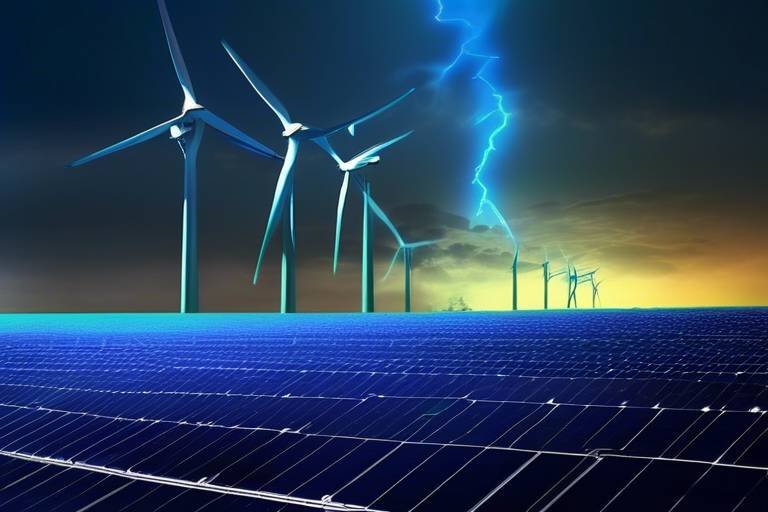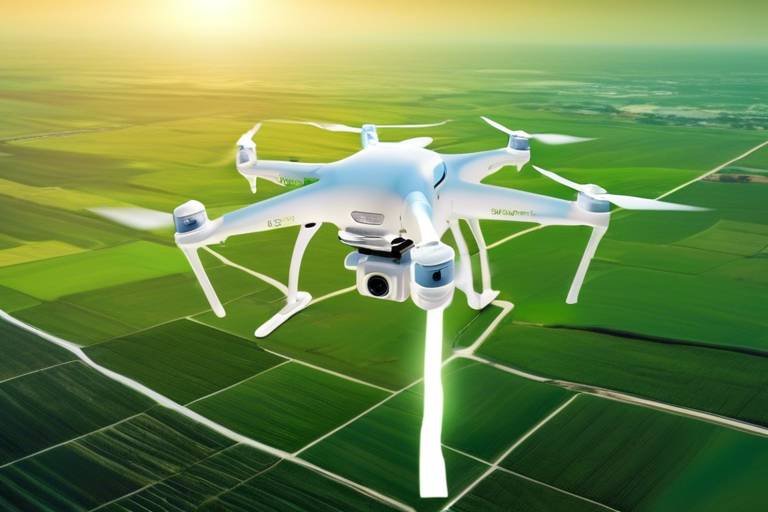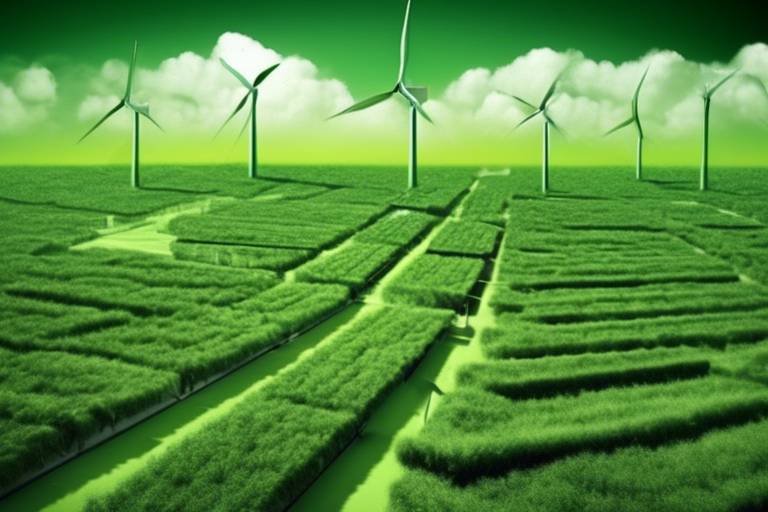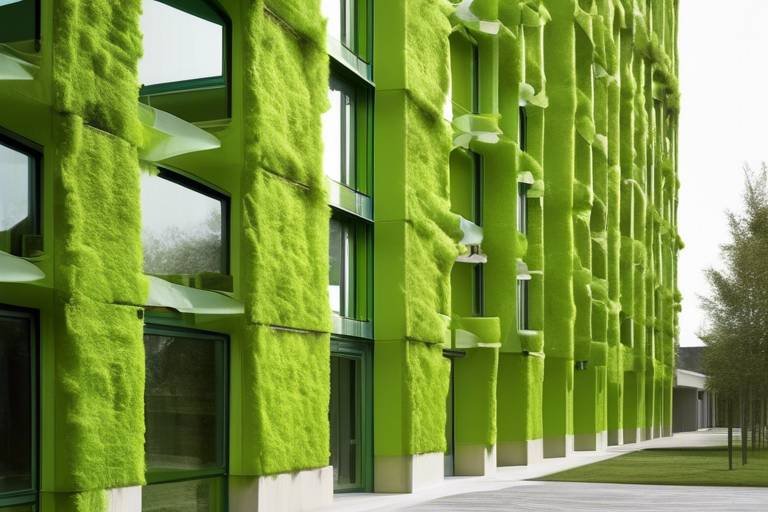The Impact of Green Energy Solutions on Wildlife
As the world pivots towards sustainable living, green energy solutions have emerged as a beacon of hope for combating climate change and promoting ecological balance. But what does this shift mean for our wildlife? This article delves into the intricate relationship between renewable energy sources—like solar and wind power—and the diverse ecosystems they inhabit. While the benefits are significant, it’s crucial to explore both the positive impacts and the challenges that come with implementing these technologies. Are we really doing enough to protect our furry, feathered, and finned friends while harnessing the power of nature?
Green energy solutions encompass a variety of renewable energy sources such as solar, wind, and hydroelectric power. These alternatives are designed to lower carbon emissions, reduce reliance on fossil fuels, and promote sustainability. However, as we embrace these innovations, we must also consider their effects on surrounding wildlife and natural habitats. It’s a delicate balance, akin to walking a tightrope where one misstep could lead to ecological disruption. Are we prepared to make the necessary adjustments to ensure that wildlife thrives alongside our energy advancements?
Implementing green energy can significantly reduce habitat destruction and pollution, leading to healthier ecosystems. For instance, the shift from coal to wind power has been shown to decrease air pollution, which in turn benefits wildlife health. Moreover, renewable energy projects often prioritize conservation efforts, promoting biodiversity. Imagine a world where solar farms not only generate energy but also serve as sanctuaries for local wildlife. This dual purpose can be a game-changer for conservation efforts.
Green energy projects frequently include habitat restoration initiatives, which can support local wildlife populations. These initiatives not only help restore degraded habitats but also create new opportunities for species to thrive. For example, when a solar farm is installed, the surrounding land can be rehabilitated to support native flora and fauna. This holistic approach ensures that energy production does not come at the expense of our natural world.
Examining specific case studies reveals how green energy projects have successfully restored habitats, benefiting various species and promoting ecological balance in the region. In one notable case, a wind farm in California implemented a comprehensive habitat restoration plan that revitalized local grasslands, leading to a resurgence of native bird populations. Such examples highlight the potential for renewable energy to be a force for good in wildlife conservation.
Engaging local communities in habitat restoration efforts can enhance wildlife conservation. When residents participate in these projects, they develop a deeper connection to their environment, which fosters a sense of stewardship. Community-led initiatives can be incredibly effective, as locals often have valuable insights into the specific needs of their ecosystems. By working together, we can ensure that sustainable practices are not just a top-down approach but a collective effort that brings everyone on board.
Despite the benefits, green energy solutions can pose challenges to wildlife, including habitat disruption and species displacement. For instance, the construction of wind turbines may interfere with migratory paths or nesting sites. It’s essential to address these potential negative impacts proactively. After all, we want to harness the wind and sun without jeopardizing the very creatures we aim to protect. The question remains—how can we strike a balance between development and conservation?
To minimize adverse effects on wildlife, various mitigation strategies can be employed. These strategies aim to create a harmonious coexistence between green energy development and wildlife conservation. For example, conducting thorough environmental assessments before project initiation can help identify critical habitats that need protection. Additionally, implementing adaptive management practices allows for ongoing adjustments based on new data and research findings.
Designing energy infrastructure with wildlife in mind can significantly reduce harm. Innovative approaches, such as creating bird-friendly turbine designs or establishing wildlife corridors around solar farms, can support both energy production and ecological health. Imagine a future where energy installations are designed not just to harness power but to coexist peacefully with nature. This vision is not far-fetched; it’s a necessary step towards sustainable energy solutions.
Ongoing research and monitoring are essential for understanding the impacts of green energy on wildlife. By collecting data on wildlife behavior and population dynamics in relation to energy projects, we can adapt our strategies to ensure that both energy needs and wildlife conservation goals are met. This commitment to research is akin to having a compass guiding us through uncharted waters, ensuring we remain on the right path toward sustainability.
- How do green energy solutions benefit wildlife? Green energy solutions help reduce pollution and habitat destruction, promoting healthier ecosystems for wildlife.
- What are some challenges faced by wildlife due to green energy? Challenges include habitat disruption and potential displacement of species during the construction and operation of renewable energy projects.
- How can communities get involved in wildlife conservation related to green energy? Communities can participate in habitat restoration initiatives and support local conservation efforts, fostering a sense of stewardship.
- What mitigation strategies can be employed to protect wildlife? Effective strategies include thorough environmental assessments, adaptive management practices, and designing wildlife-friendly infrastructure.

Understanding Green Energy Solutions
Green energy solutions are revolutionizing the way we think about power generation and its impact on our planet. These solutions primarily include renewable energy sources such as solar, wind, and hydroelectric power. Unlike traditional fossil fuels, which are notorious for their high carbon emissions and detrimental effects on the environment, green energy aims to harness natural processes to generate electricity. Imagine capturing the sun's rays or harnessing the wind's power; it’s like tapping into nature’s own battery. But while we celebrate these innovations, it's crucial to consider their effects on wildlife and ecosystems.
Renewable energy sources are not just about reducing pollution; they also offer a pathway to sustainability. For instance, solar panels can be installed on rooftops, which minimizes land use and reduces habitat destruction. Wind turbines, when strategically placed, can generate significant amounts of energy without requiring extensive land clearing. However, it's essential to recognize that the implementation of these technologies can sometimes disrupt local wildlife. The challenge lies in finding a balance between harnessing these green energy solutions and protecting our precious ecosystems.
The impact of green energy solutions on wildlife can be both positive and negative. On the one hand, they can lead to reduced habitat destruction and lower pollution levels, fostering healthier ecosystems. On the other hand, the construction and operation of renewable energy facilities can displace wildlife and alter their habitats. For example, wind farms can pose a risk to birds and bats, while solar farms can disrupt local flora and fauna if not carefully designed. Therefore, understanding these dynamics is crucial for developing strategies that promote both energy production and wildlife conservation.
To truly grasp the implications of green energy solutions, we must consider the broader context of environmental sustainability. This includes recognizing the importance of biodiversity and how different species interact within their ecosystems. Renewable energy projects should ideally enhance biodiversity by creating habitats or restoring degraded areas. For example, some solar farms are designed with native vegetation, which can provide habitats for local wildlife. This dual-purpose approach can make renewable energy a friend to both people and nature.
In summary, understanding green energy solutions requires a multifaceted approach that considers their benefits and challenges. As we move towards a more sustainable future, it's imperative that we prioritize wildlife conservation alongside energy development. By doing so, we can ensure that our transition to renewable energy not only powers our homes but also protects the natural world we cherish.

Benefits of Green Energy for Wildlife
Implementing green energy solutions like solar and wind power can significantly benefit wildlife and ecosystems. One of the most compelling advantages is the reduction of habitat destruction and pollution. Traditional energy sources, such as fossil fuels, often lead to devastating environmental impacts, including habitat loss and air and water pollution. In contrast, renewable energy projects aim to minimize these harmful effects, creating healthier ecosystems that support diverse wildlife populations.
Moreover, green energy initiatives can promote biodiversity by providing safe havens for various species. For instance, solar farms can be designed to coexist with local flora and fauna, allowing wildlife to thrive in areas that were previously unsuitable for habitation due to industrial activities. These renewable energy projects can also lead to the creation of new habitats, which can be particularly beneficial for endangered species. By integrating wildlife corridors and preserving natural landscapes, we can ensure that energy production does not come at the expense of our planet's precious biodiversity.
Another critical aspect of green energy is its role in habitat restoration initiatives. Many renewable energy projects incorporate efforts to restore degraded habitats, which can help local wildlife populations rebound. For example, when a wind farm is established, the surrounding area can be rehabilitated to support native plant species and provide shelter for various animals. These restoration efforts not only enhance the ecological integrity of the region but also foster a sense of community involvement and stewardship.
Examining specific case studies illustrates the positive outcomes of green energy projects on wildlife habitats. One notable example is the California solar initiative, where solar farms have been coupled with extensive habitat restoration efforts. These projects have successfully revitalized local ecosystems, leading to a resurgence of native species and improved ecological balance. Such case studies highlight the potential for green energy solutions to act as a catalyst for environmental recovery.
Engaging local communities in habitat restoration is crucial for enhancing wildlife conservation. When community members participate in these initiatives, they develop a deeper connection to their environment and a greater appreciation for the wildlife that inhabits it. This involvement can take many forms, such as volunteering for restoration projects or participating in educational programs that promote sustainable practices. By fostering a sense of ownership and responsibility, we can create a culture that values both green energy development and wildlife conservation.
In summary, the benefits of green energy for wildlife extend far beyond mere energy production. By reducing habitat destruction, promoting biodiversity, and engaging communities in restoration efforts, green energy solutions can create a more harmonious balance between energy needs and ecological health. As we move forward in our quest for sustainability, it is essential to recognize and amplify these benefits to ensure a brighter future for both wildlife and humanity.

Habitat Restoration Initiatives
When we think about green energy, the first thing that often comes to mind is the reduction of carbon footprints and cleaner air. However, one of the most significant yet sometimes overlooked benefits is the potential for habitat restoration. Green energy projects, particularly those involving solar and wind power, frequently include initiatives aimed at restoring degraded ecosystems. These efforts not only help in energy production but also play a crucial role in supporting and revitalizing local wildlife populations.
For instance, many solar farms are designed with the intention of promoting biodiversity. They can transform previously barren or agricultural lands into vibrant ecosystems. By planting native vegetation around solar panels, these projects can create new habitats for various species, including pollinators, birds, and small mammals. This approach not only enhances the ecological value of the site but also helps in mitigating soil erosion and improving water retention, which are essential for a healthy environment.
Moreover, wind energy projects have also demonstrated significant potential for habitat restoration. In some cases, areas that were once used for conventional energy production, like coal mining or oil drilling, are being repurposed for wind farms. This transition allows for the recovery of damaged landscapes and the re-establishment of native flora and fauna. By prioritizing ecological balance, these initiatives ensure that wildlife can thrive in areas that were previously detrimental to their existence.
To illustrate the impact of these initiatives, let's look at a few successful case studies:
| Project Name | Location | Type of Energy | Wildlife Benefits |
|---|---|---|---|
| Solar Habitat Project | California | Solar | Restored habitats for pollinators and small mammals |
| Wind Farm Restoration | Texas | Wind | Reestablished native grasslands for bird species |
| Hydro Restoration Initiative | Oregon | Hydroelectric | Improved fish migration routes and wetland areas |
These examples highlight how green energy projects can serve dual purposes: generating renewable energy while simultaneously restoring and enhancing wildlife habitats. But it's not just about the projects themselves; community involvement is also pivotal in these restoration initiatives. Engaging local communities not only fosters a sense of ownership but also encourages sustainable practices that benefit both people and wildlife.
In many cases, local volunteers participate in planting native species, removing invasive plants, and creating educational programs aimed at raising awareness about the importance of biodiversity. This collaboration between energy developers and local residents can lead to innovative solutions that enhance both energy production and ecological health.
In summary, habitat restoration initiatives associated with green energy projects are a win-win scenario. They not only contribute to the fight against climate change but also play a significant role in conserving and enhancing wildlife populations. By embracing these initiatives, we can ensure that our transition to renewable energy is not only sustainable but also beneficial for the planet's rich biodiversity.

Case Studies in Habitat Restoration
When it comes to the intersection of green energy and wildlife conservation, case studies serve as illuminating examples of how renewable energy projects can lead to effective habitat restoration. One standout example is the Solar Energy Project in California’s Mojave Desert. This initiative not only harnesses solar power but also incorporates extensive habitat restoration efforts. By planting native vegetation and creating wildlife corridors, the project has significantly improved conditions for desert tortoises and other local species. The restoration efforts have seen a remarkable increase in biodiversity, showcasing how energy production and ecological health can go hand in hand.
Another compelling case is the Wind Farm in the Midwest. Here, developers recognized the potential impact on local bird populations and took proactive measures. They partnered with conservation organizations to conduct pre-construction assessments and implemented strategies such as turbine placement away from critical migratory paths. The result? A wind farm that produces clean energy while minimizing risks to avian species. This case underscores the importance of thoughtful planning and community collaboration in achieving a balance between energy development and wildlife protection.
In addition to these projects, the Hydroelectric Restoration Initiative in the Pacific Northwest provides further evidence of successful habitat restoration linked to green energy. This initiative involved retrofitting existing dams with fish ladders and creating bypass channels to facilitate the migration of salmon and other aquatic species. The restoration has not only improved fish populations but has also revitalized surrounding ecosystems, benefiting a myriad of wildlife. These case studies exemplify how green energy solutions can lead to innovative habitat restoration practices that foster ecological balance.
Moreover, these projects emphasize the need for ongoing collaboration between energy developers, conservationists, and local communities. Engaging stakeholders from the outset ensures that the ecological needs of wildlife are integrated into the planning and execution phases of energy projects. As we continue to explore green energy solutions, the lessons learned from these case studies will be invaluable in shaping future initiatives that prioritize both sustainable energy production and wildlife conservation.
- What are green energy solutions?
Green energy solutions refer to renewable energy sources such as solar, wind, and hydroelectric power that aim to reduce environmental impact and promote sustainability. - How do green energy projects benefit wildlife?
These projects can lead to habitat restoration, reduced pollution, and improved ecosystems, which collectively enhance wildlife conservation efforts. - What challenges do wildlife face from green energy solutions?
Challenges include habitat disruption, species displacement, and potential risks to local wildlife populations, which must be carefully managed. - How can we mitigate the negative impacts of green energy on wildlife?
Mitigation strategies include designing wildlife-friendly energy infrastructure, conducting thorough research, and involving local communities in conservation efforts.

Community Involvement in Restoration
When it comes to wildlife conservation, the phrase “it takes a village” couldn’t be more accurate. Community involvement in habitat restoration is not just beneficial; it’s essential for the success of green energy projects. Local communities possess invaluable knowledge about their environment, which can significantly enhance restoration efforts. By engaging residents, we create a sense of ownership and responsibility towards the land, fostering a culture of sustainability. Imagine a group of neighbors coming together to plant trees or clean up a local river; it’s not just about the physical act but also about building relationships and a shared vision for a healthier ecosystem.
One of the most effective ways communities can engage in restoration is through organized volunteer programs. These initiatives often involve a variety of activities, such as:
- Planting native vegetation to restore natural habitats
- Monitoring local wildlife populations
- Participating in educational workshops about sustainable practices
- Creating awareness campaigns to inform others about the importance of conservation
Moreover, community involvement can lead to innovative solutions tailored to local needs. For example, a small town might initiate a solar panel installation project that not only generates clean energy but also includes landscaping that supports local wildlife. This dual approach not only maximizes the benefits of green energy but also ensures that the local ecosystem thrives alongside it.
To illustrate the impact of community involvement, let’s take a look at a few successful case studies:
| Project Name | Location | Community Role | Outcome |
|---|---|---|---|
| Green River Restoration | Oregon | Local volunteers planted over 5,000 native trees | Increased biodiversity and improved water quality |
| Solar for Schools | California | Students participated in installation and education | Enhanced environmental awareness and reduced energy costs |
| Wetland Revival | Florida | Community workshops on wetland preservation | Restored habitats for endangered species |
Involving the community in restoration efforts not only empowers individuals but also cultivates a collective responsibility towards the environment. When people see the tangible results of their efforts, it inspires further action and commitment. This cycle of engagement and restoration can lead to long-term benefits for both the community and local wildlife.
As we move forward in implementing green energy solutions, it is crucial to recognize that community involvement is a cornerstone of successful habitat restoration. By harnessing local knowledge and enthusiasm, we can create a brighter, more sustainable future for our wildlife and ecosystems.
Q: How can I get involved in local restoration projects?
A: Many communities have organizations dedicated to environmental conservation. Check local websites or social media for upcoming volunteer events.
Q: What are the benefits of community involvement in restoration?
A: Engaging the community fosters a sense of ownership, encourages sustainable practices, and leads to more effective restoration efforts.
Q: Can small actions really make a difference?
A: Absolutely! Even small contributions, like planting a few trees or participating in clean-up days, can have a significant cumulative impact on local ecosystems.

Challenges Faced by Wildlife
While green energy solutions are heralded for their potential to create a sustainable future, they also bring a set of challenges that can significantly impact wildlife. One of the most pressing issues is habitat disruption. When solar farms or wind turbines are constructed, the natural habitats of various species can be altered or completely destroyed. Imagine a bustling forest or a serene wetland being replaced by rows of solar panels or towering wind turbines. This transformation can lead to a loss of food sources and nesting sites for many animals.
Moreover, the construction and operation of these energy projects can cause species displacement. Animals that once thrived in these areas may find themselves forced to relocate, which can be particularly detrimental for species that are already endangered or have limited ranges. For instance, birds that migrate through areas slated for wind farms may face increased mortality rates due to collisions with turbine blades, leading to a decline in their populations.
In addition to habitat loss and species displacement, noise pollution from wind turbines can disrupt the natural behaviors of wildlife. Many animals rely on sound for communication, mating, and navigation. The constant hum of turbines can interfere with these vital processes, causing stress and disorientation among various species. Similarly, the construction phase of green energy projects often involves heavy machinery, which can create a cacophony that further disturbs local wildlife.
Another challenge is the fragmentation of ecosystems. As renewable energy projects are developed, they can create barriers that separate wildlife populations, making it difficult for them to migrate, find mates, or access resources. This fragmentation can lead to inbreeding and a decrease in genetic diversity, which is essential for the resilience of species in the face of environmental changes.
To better understand these challenges, it's important to consider the specific impacts on different types of wildlife. For example, aquatic species may be affected by hydroelectric projects that alter water flow and temperature, while terrestrial animals might struggle with the loss of their habitats due to solar farms. The table below outlines some of the key challenges faced by various wildlife groups as a result of green energy implementation:
| Wildlife Group | Challenges Faced |
|---|---|
| Birds | Collision with turbines, habitat loss, noise pollution |
| Mammals | Habitat fragmentation, displacement, stress from construction noise |
| Aquatic Species | Altered water flow, temperature changes, habitat degradation |
| Insects | Habitat loss, pesticide exposure from surrounding agriculture |
In conclusion, while the transition to green energy is essential for combatting climate change and promoting sustainability, it is crucial to address the challenges faced by wildlife. By recognizing these issues, we can work towards solutions that minimize negative impacts and promote coexistence between renewable energy initiatives and the natural world. Understanding the balance between energy production and wildlife conservation is not just a necessity; it is our responsibility as stewards of the planet.
- What are some ways to mitigate the impact of green energy projects on wildlife?
Implementing wildlife-friendly infrastructure, conducting thorough environmental assessments, and involving local communities in conservation efforts are some effective strategies. - How can we balance renewable energy development with wildlife conservation?
By prioritizing ecological considerations in the planning stages of energy projects and adopting adaptive management practices, we can find a balance that supports both goals. - Are there any success stories of wildlife conservation alongside green energy projects?
Yes! Many renewable energy projects include habitat restoration initiatives that have successfully improved local ecosystems and supported wildlife populations.

Mitigation Strategies for Wildlife Protection
As we continue to embrace the power of green energy solutions, it becomes increasingly crucial to address the potential impacts on wildlife. Fortunately, there are several effective mitigation strategies that can be employed to protect our precious ecosystems while still harnessing the benefits of renewable energy. One of the most promising approaches involves designing energy infrastructure that is wildlife-friendly. By considering the needs of local species during the planning stages of energy projects, we can significantly reduce habitat disruption and promote coexistence.
For instance, wind farms can be designed with careful attention to bird migration patterns and bat populations. This can include placing turbines in areas less frequented by these animals, utilizing technology to detect their presence, and even implementing seasonal shutdowns during peak migration times. Such strategies not only protect wildlife but also enhance the sustainability of energy production.
Moreover, ongoing monitoring and research efforts are essential for understanding the dynamic relationship between green energy projects and wildlife. By collecting data on wildlife populations and their behavior in response to energy infrastructure, researchers can develop adaptive management practices that ensure both energy needs and wildlife conservation goals are met. This proactive approach allows us to make informed decisions and adjust our strategies based on real-world outcomes.
Engaging local communities is another vital component of successful mitigation strategies. When communities are involved in the planning and implementation of green energy projects, they can provide valuable insights into local wildlife and habitat conditions. This collaboration fosters a sense of ownership and responsibility towards wildlife conservation. For example, community-led initiatives that focus on habitat restoration can complement energy projects, creating a win-win situation for both energy producers and wildlife advocates.
In addition to community engagement, it’s crucial to implement educational programs that raise awareness about the importance of wildlife protection in the context of green energy. By informing the public about the potential challenges and solutions, we can cultivate a culture of conservation that supports sustainable practices. This educational outreach can be facilitated through workshops, school programs, and local events that highlight the benefits of biodiversity and the role of renewable energy in preserving it.
In summary, the path to a greener future does not have to come at the expense of our wildlife. By prioritizing wildlife-friendly energy infrastructure, committing to ongoing research, engaging local communities, and implementing educational programs, we can create a harmonious balance between energy production and wildlife conservation. The journey towards sustainability is a collective effort, and with the right strategies in place, we can ensure that both our planet and its inhabitants thrive.
- What are some examples of wildlife-friendly energy infrastructure?
Wildlife-friendly energy infrastructure includes strategies like placing wind turbines away from migration routes, using bird-safe glass in solar installations, and creating wildlife corridors around energy sites. - How can communities get involved in wildlife protection related to green energy?
Communities can participate by engaging in local planning processes, joining habitat restoration projects, and advocating for wildlife considerations in energy developments. - What role does research play in mitigating impacts on wildlife?
Research helps identify the effects of energy projects on wildlife, guiding adaptive management practices that can reduce negative impacts and promote coexistence.

Wildlife-Friendly Energy Infrastructure
When it comes to developing green energy solutions, one of the most pressing concerns is how to create . This involves designing and implementing energy systems that not only produce renewable energy but also consider the habitats and behaviors of local wildlife. Imagine a world where wind turbines spin gracefully without disrupting the flight paths of birds or where solar panels are integrated into landscapes in a way that preserves natural habitats. Sounds ideal, right?
To achieve this vision, energy developers are increasingly adopting innovative strategies that prioritize ecological health. For instance, when planning wind farms, developers can conduct thorough environmental assessments to identify crucial wildlife migration routes. By strategically placing turbines away from these paths, they can significantly reduce the risk of bird collisions. Moreover, using avian-friendly turbine designs can further mitigate these risks. These designs often feature larger rotor blades that spin more slowly, making it easier for birds to avoid them.
Another exciting development is the integration of solar panels into existing structures, such as rooftops or parking lots, which minimizes land use and preserves surrounding ecosystems. This approach not only generates clean energy but also protects valuable wildlife habitats from being disrupted. Additionally, utilizing dual-use solar farms—where solar panels are installed over agricultural land—can create a win-win situation. Farmers benefit from the energy produced while still being able to cultivate their crops, and the land remains a habitat for various species.
Furthermore, incorporating natural features into energy infrastructure is gaining traction. For example, creating wildlife corridors around solar farms or wind farms allows animals to safely navigate through their territories without encountering barriers. These corridors can be designed with native vegetation, providing food and shelter for local wildlife. By ensuring that energy projects are harmoniously integrated into the landscape, we can promote biodiversity while still harnessing the power of renewable energy.
Ultimately, the goal is to create a synergy between energy production and wildlife conservation. This requires collaboration among energy developers, environmentalists, and local communities. By engaging in open dialogues and sharing knowledge, stakeholders can develop solutions that benefit both the environment and energy needs.
In summary, is not just a lofty ideal; it's an achievable reality with the right planning and commitment. By prioritizing the needs of wildlife in the development of green energy projects, we can ensure that our transition to renewable energy is both sustainable and respectful of the natural world.

Monitoring and Research Efforts
When it comes to the intersection of green energy solutions and wildlife, monitoring and research efforts are absolutely crucial. Why, you ask? Well, understanding the impacts of renewable energy projects on wildlife populations and their habitats is key to ensuring that we can create a balance between energy production and ecological health. Without these efforts, we might be flying blind into the future, potentially harming the very ecosystems we aim to protect.
Research initiatives often involve a combination of field studies, data collection, and advanced technologies such as satellite tracking and remote sensing. These methods allow scientists to gather valuable information about wildlife behavior and habitat use in areas where green energy projects are implemented. For instance, researchers can monitor migratory patterns of birds near wind farms to assess any potential disruptions caused by turbine installations. By analyzing this data, we can develop strategies to mitigate negative impacts and enhance wildlife conservation.
Moreover, collaboration between energy companies, environmental organizations, and academic institutions is vital for effective monitoring. When these groups come together, they can create comprehensive research programs that not only track wildlife populations but also assess the health of ecosystems. This collaborative approach ensures that all stakeholders have a voice in the decision-making process, leading to more sustainable practices and policies.
One innovative research method includes the use of camera traps and acoustic monitoring to study wildlife presence and behavior in renewable energy sites. These technologies provide real-time data, enabling researchers to observe how wildlife interacts with their environment in the context of energy production. The insights gained from such studies can inform the design and operation of energy projects, making them more wildlife-friendly.
To illustrate the importance of monitoring efforts, consider the following table that outlines key research areas and their impacts:
| Research Area | Purpose | Impact on Wildlife |
|---|---|---|
| Bird Migration Studies | Track migratory patterns near wind farms | Identifies potential collision risks and informs turbine placement |
| Habitat Use Assessments | Evaluate how wildlife utilizes habitats in energy project areas | Helps in habitat restoration efforts and planning |
| Community Engagement Surveys | Gather local insights on wildlife interactions with energy projects | Fosters community involvement and improves conservation strategies |
In conclusion, ongoing monitoring and research efforts are not just beneficial; they are essential for the future of wildlife in the context of green energy solutions. As we continue to harness renewable energy, we must remain vigilant and proactive in understanding its effects on the natural world. Only through dedicated research and collaboration can we ensure that our pursuit of sustainability does not come at the expense of biodiversity.
- What are the main methods used for monitoring wildlife near green energy projects?
Common methods include satellite tracking, camera traps, and acoustic monitoring to observe wildlife behavior and habitat use. - How can local communities get involved in wildlife monitoring?
Communities can participate in surveys, data collection, and habitat restoration initiatives, fostering a sense of ownership and responsibility. - What are the potential negative impacts of green energy on wildlife?
Impacts can include habitat disruption, species displacement, and collision risks with energy infrastructure, such as wind turbines. - How can we mitigate the negative effects of green energy on wildlife?
Implementing wildlife-friendly designs, conducting thorough impact assessments, and engaging in ongoing monitoring can help mitigate these effects.
Frequently Asked Questions
- What are green energy solutions?
Green energy solutions refer to renewable energy sources like solar, wind, and hydroelectric power. These alternatives are designed to reduce carbon emissions and promote sustainability while considering their effects on wildlife and natural habitats.
- How do green energy projects benefit wildlife?
Green energy projects can lead to reduced habitat destruction and pollution, which creates healthier ecosystems. They often include habitat restoration initiatives that support local wildlife populations, promoting biodiversity and ecological balance.
- What are some challenges that wildlife face from green energy solutions?
While green energy has its benefits, it can also pose challenges such as habitat disruption and species displacement. These impacts can affect local wildlife populations, making it essential to address them through effective mitigation strategies.
- What mitigation strategies are used to protect wildlife?
To minimize adverse effects, various mitigation strategies can be employed, including designing wildlife-friendly energy infrastructure and implementing ongoing research and monitoring efforts. These practices help balance energy development with wildlife conservation.
- How can communities get involved in wildlife conservation related to green energy?
Community involvement is crucial in habitat restoration efforts. By engaging local populations in sustainable practices and green energy initiatives, we can enhance wildlife conservation and promote ecological health in the region.
- Are there any successful case studies of green energy projects benefiting wildlife?
Yes! Several case studies demonstrate how green energy projects have successfully restored habitats and benefited various species. These examples highlight the potential for renewable energy to promote ecological balance while supporting energy production.
- How important is monitoring and research in green energy projects?
Monitoring and research are vital for understanding the impacts of green energy on wildlife. Ongoing data collection and adaptive management practices ensure that we can make informed decisions to promote coexistence between energy development and wildlife conservation.


















